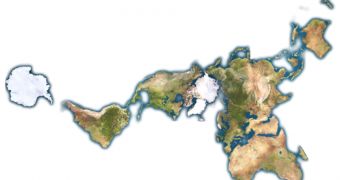According to the conclusions of a new study, it would appear that the development of life on Earth played an important role in promoting the emergence of continents. The work raises the interesting prospect of whether or not a planet without life can form continents.
In a paper published in a recent online issue of Science Direct, researchers with the Institute of Planetary Research at the German Aerospace Center (DLR), the Institute of Geological Sciences at the Free University Berlin and the Institute of Planetology at the University of Münster say that life may be required for the formation of continents.
In the paper, the team argues that an Earth without life would have now been covered almost entirely in oceans, and that very small areas of dry land would have been able to develop. If true, this conclusion may have significant implications for our search of extraterrestrial life on other planets.
In addition to being the only planet known to support liquid water on its surface, Earth also features continental landmasses covering more than 30 percent of its surface. Some existing telescopes, and several planned ones, will be able to detect oceans and continents on distant exoplanets as well.
While the planet may seem too big and abstract to be influenced by life, the evidence points to the contrary. The clearest example is atmospheric oxygen, a chemical that is produced by plants, and which has not been found in similar concentrations in any other atmospheres to date.
Carbon dioxide and methane are also produced by life on Earth, and these chemicals influence the global climate to a great degree. However, until now, scientists had a much shallower understanding of how life influenced the deeper interior of our planet, says DLR IPR planetary scientist Tilman Spohn.
One of the most important things to note here is that life is believed to have emerged around 3.5 billion years ago, roughly the same time the continents did; and this suggests a connection between the two. One possible explanation could be biological weathering, a process by which bacteria destroy rocks.
Wind and water carry these destroyed rocks throughout the planet, but they eventually make their way inside subduction zones, where tectonic plates slide under one another. The moisture they insert into the mantle – between the Earth's crust and core – may contribute to increased continental formation rates.
“When the Earth's surface is recycled in subduction zones, it affects processes in the deep interior,” concludes the lead author of the new study DLR IPR planetary scientist Dennis Höning.

 14 DAY TRIAL //
14 DAY TRIAL //